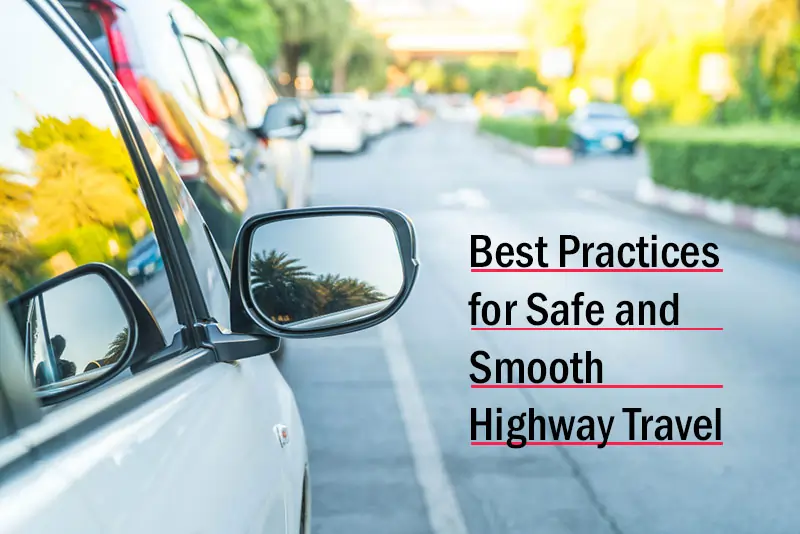Best Practices for Safe and Smooth Highway Travel

This is a prime feature of modern life since long distances are transported through highways, commerce takes place alongside highways, and most people depend on highways for mobility.
Meanwhile, such transportation has tremendous dangers attached to it, with millions of highway accidents occurring every year worldwide.
According to the World Health Organization, this is one of the leading causes of injury and death in road traffic accidents, including lane change accidents. It comes down to the point of urgent necessity for the addition of more safety measures on highways.
From pre-trip preparation to education on legal responsibilities and management of emergencies, this resource provides practical information to improve safety on our roads. Through collective awareness and proactive measures, we can work towards reducing the occurrence and severity of lane change accidents, fostering a safer environment for all travelers.
Pre-Trip Preparation
It starts much earlier than setting out for the adventure on a highway. Proper vehicle maintenance is important; many common issues can be prevented by looking at brakes, tires, fluids, and lights.
Checking that lights and signals work correctly helps ensure visibility as well as clear communication with other drivers.
Route planning is equally important, make weather forecasts and information related to traffic conditions so that one can escape the delay and hazardous conditions. Plan your route keeping in mind rest stops and refueling points so that both your vehicle and you can be in good endurance.
An emergency kit is a travel necessity.Travel with a first aid kit, flashlight, basic tools, water, and non-perishable foods. A wise idea is to keep a charged mobile along with a car charger so that help can be called in case of emergency. Proper preparation will not only make your travel safer but also more relaxed, letting you actually enjoy driving.
On the Road: Driving Practices
Once you get onto the highway, observe safe driving practices that help to decrease risks and have you moving throughout the evening safely. Some of the practices to follow include:
- Adhering to Speed Limits: It always has to be followed for safety both on one’s part and on other people’s part. Always remember that speeding increases the chances of causing an accident and also increases the severity of accidents. Avoid extremely slow driving as it brings about traffic flow disarrangement and also causes accidents sometimes.
- Maintaining Safe Following Distance: Utilize the three-second rule: leave at least a three-second gap between your vehicle and the one ahead. Extend the distance in bad weather, for instance, heavy downpour, fog, or especially during rush hour. A buffer area like this will provide enough time to respond to such sudden stoppages or emergencies.
- Lane Discipline: Drive on the extreme right-hand side only at relatively slower speeds; use the left lane only to pass other vehicles. Signal your intention to change lanes and then change lane with consideration for other road users. Check your mirrors and blind spots before you change lanes.
- Avoiding Distractions: Refrain from using cell phones or ask someone to let you make use of hands-free devices if it’s something that must be communicated. Set your GPS routes and adjust the settings before you start driving so you wont get distracted. Do not eat, drink, or engage in any other activity that could distract you from the road.
- Defensive Driving: Anticipate the actions of other drivers and be prepared to react safely. Be vigilant and keep track of your surroundings at all times. Never adopt aggressive driving styles like tailgating or tail-slinging
Dealing with Emergencies
Emergencies may arise suddenly, and knowing how to act can save lots of precious time. In case the vehicle breaks down, pull over carefully on to the shoulder of the road. Ideally, keep a distance from any roadside hazards.
Turn on your hazard lights, and if you have them, use emergency triangles or flares to make yourself more visible to other drivers. If it’s possible, you should stay inside your vehicle and wait for assistance.
If you’re in an accident, try to keep calm and assess who might be injured in the vehicle. If it is safe to do so, move your vehicle off of the traffic lane to prevent other accidents. Call the local emergency services department and give the correct information.
Related reading: Empowering Young Drivers: The Value of Awareness Programs
Safety Measures for Various Conditions
Driving conditions can be quite different, and one has to adjust the driving accordingly in order to ensure safety.
- Night Driving: Clean your headlights and make sure they are functioning properly. High beams are quite useful for increasing visibility while moving around, but when approaching vehicles, the beam should be reduced to low beam to avoid glare. Get enough rest. Fatigue is the main culprit as natural vision is impaired in night.
- Adverse Weather Conditions: Reduce speed and increase the following distance to account for decreased traction and longer stopping distances. Use headlights and windshield wipers effectively to improve visibility and vehicle control. Be cautious of hydroplaning in wet conditions and avoid sudden maneuvers that can lead to skidding.
- Heavy Traffic and Congestion: Stay patient and practice defensive driving to avoid accidents caused by sudden stops and lane changes. Keep a safe distance from the vehicle ahead to allow for gradual braking. Avoid aggressive behaviors like tailgating or weaving through traffic, which can escalate road rage and increase accident risks.
Tips for Long-Distance Travel
Long distance travel requires advanced preparation and strategies for safety and comfort. Some need-to-know tips follow.
- Managing Fatigue: Take regular breaks every two hours or 100 miles to rest and stretch. Avoid driving late at night when your body is naturally inclined to sleep. Share driving responsibilities with other licensed drivers if possible.
- Staying Hydrated and Eating Light: Drink lots of water to keep your body hydrated, which also keeps you alert. Eat light food, whether it is a snack or meal, to reduce drowsiness and sleep. Steer clear of oily food because you might sleep easily.
- Comfort and Ergonomics: Adjust your seat and steering wheel to ensure a comfortable driving position. Use cushions or lumbar support to reduce back strain during long drives. Wear comfortable clothing and shoes to prevent discomfort.
- Entertainment and Mental Stimulation: Listen to an audiobook, podcast or music to refresh your mind. Prepare interactive games or activities to engage the passengers in order not to bore them during the journey. Charge all electronic devices to full capacity, carry the chargers together and ensure everything is fully charged to avoid any inconveniences during the journey.
- Planning for Rest Stops: Identify safe and convenient rest stops along your route for breaks and refueling. Use rest areas to stretch, use the restroom, and refresh yourself. Check your vehicle for any issues at a rest stop.
Related reading: 10 Ways to Make Driving With a Baby Safe and Comfortable
Highway travel can be very convenient and be so much fun when covering long distances, but it does require a commitment to safety and preparation.
Pre-trip preparation ensures that your vehicle is in optimum condition and that you have prepared for any emergencies. Safe driving practices and adaptation to conditions further enhance the safety of an individual and others on the road.
Safe highway traveling relies on precautionary measures, awareness, and responsible driving behavior. Through the enactment of these practices by you in your travel, you help create a safer driving environment and a more relaxed and pleasant journey. Let friends and fellow drivers benefit from this knowledge to promote this common good of highway safety.

